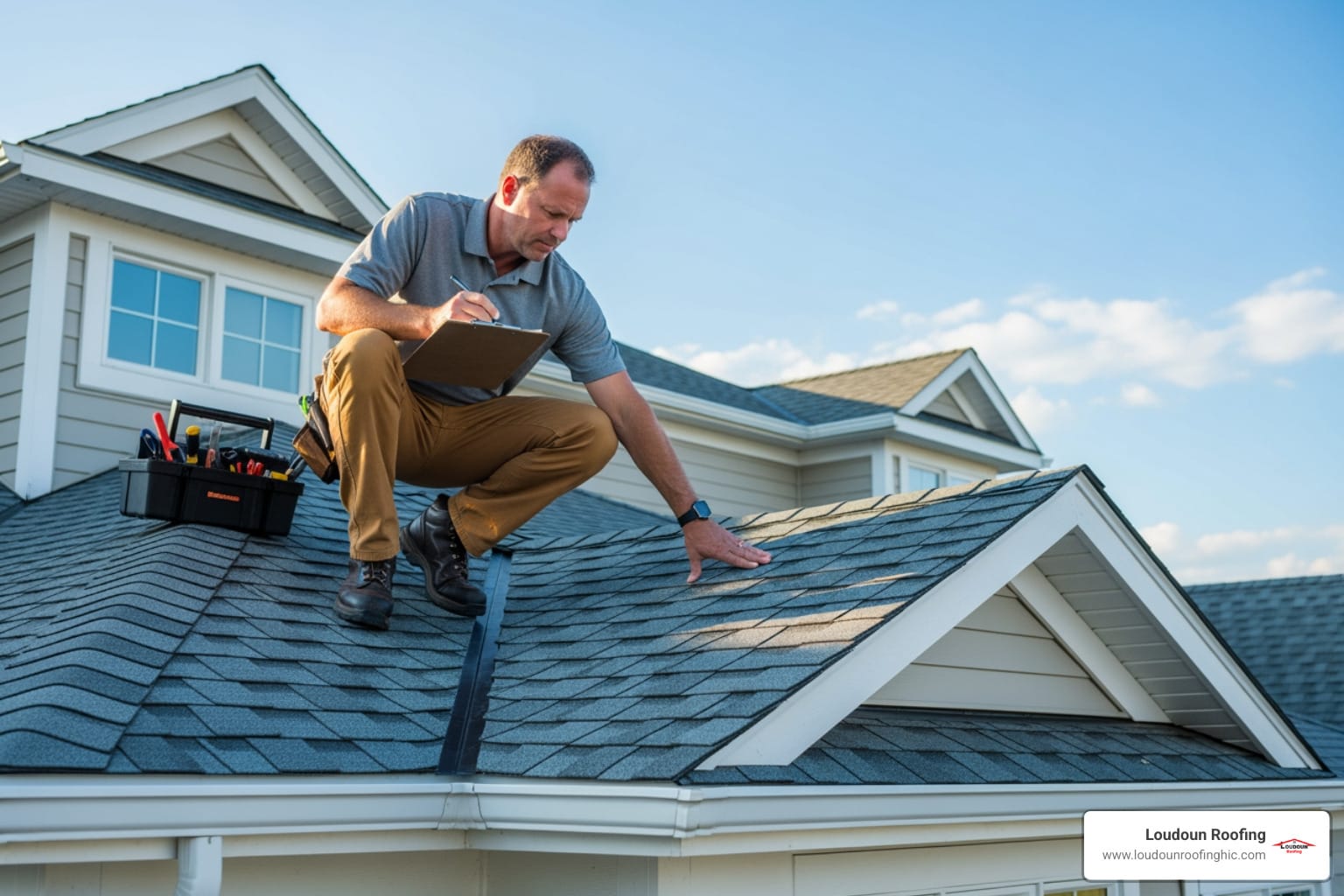Why 20-Year Asphalt Roofing Shingles Matter for Budget-Conscious Homeowners
Choosing a new roof is a major decision, and for many homeowners, finding a balance between cost and quality is paramount. As a trusted local roofing partner for communities across Northern Virginia, we know that understanding your options is the first step. 20 year asphalt roofing shingles are the most affordable option in the asphalt shingle market, making them an attractive choice for homeowners working within tight budgets or specific project constraints.
Key Facts About 20-Year Asphalt Roofing Shingles:
- Type: Typically 3-tab shingles with a straightforward, single-layer construction.
- Real Lifespan: 15-18 years in Northern Virginia, where humid summers and freeze-thaw cycles in winter accelerate wear.
- Thickness: The thinnest and lightest among all asphalt shingle options, contributing to their low cost.
- Wind Resistance: Generally rated for 60 mph winds, which can be a vulnerability during severe summer thunderstorms or coastal storms.
- Best For: Budget-driven projects, rental properties, outbuildings like sheds and garages, or homes you plan to sell in the near future.
- Warranty: A 20-year limited manufacturer warranty that is almost always prorated, meaning coverage decreases over time.
- Cost: The lowest upfront investment, but this initial savings is offset by a higher replacement frequency and potentially higher lifetime cost.
When considering your roofing options, it’s important to understand that the “20-year” designation refers to the manufacturer’s limited warranty period, not a guarantee of how long the shingles will perform optimally. These shingles use basic materials—a fiberglass mat core with a thinner asphalt coating and protective mineral granules—which contributes to both their affordability and shorter expected lifespan. Over time, this thinner construction is more susceptible to curling, cracking, and granule loss.
For homeowners in Northern Virginia seeking durable roofing solutions, understanding the trade-offs between initial cost savings and long-term performance is crucial for making an informed decision.
As Esteban Marin, owner of Loudoun Roofing with over two decades of roofing experience since 2001, I’ve installed countless 20 year asphalt roofing shingles on properties throughout Loudoun County. While these shingles serve specific purposes well, I always ensure homeowners understand both their benefits and limitations before making their final choice. My team has seen how they perform in local conditions, from Leesburg to Ashburn, and we bring that experience to every consultation.

What Are the Defining Characteristics of a 20-Year Shingle?

When you’re shopping for 20 year asphalt roofing shingles, you’re almost certainly looking at what we call 3-tab shingles. These are the tried-and-true workhorses of the roofing world—simple, straightforward, and designed with affordability as the primary goal. As a trusted roofing contractor serving Northern Virginia, I’ve installed thousands of these shingles over the years, and their defining features make them instantly recognizable and suitable for specific applications.
The most obvious characteristic is their single-layer construction, which creates a flat, uniform appearance across your entire roof. Unlike their more complex cousins, architectural shingles, these shingles don’t try to mimic the rustic look of wood shakes or slate tiles. Instead, they offer a clean, classic, and consistent pattern that has been a staple on American homes for generations, particularly on ranch-style houses and more traditional designs.
What makes them so budget-friendly is their basic material composition. Each shingle starts with a fiberglass mat core that serves as the structural backbone. This mat is then saturated with asphalt for waterproofing and finished with a layer of protective mineral granules that shield the asphalt from damaging UV rays and weather. If you’d like to dive deeper into how these materials work together, you can find more info about asphalt shingle roofs on our website.
The “3-Tab” Design Explained
The name “3-tab” isn’t just roofing jargon—it perfectly describes the shingle’s appearance. Each long shingle strip is precisely cut during manufacturing to create three distinct tabs of equal size along the bottom edge. When installed in overlapping courses, these tabs line up to form the neat, repetitive rows that give a 3-tab roof its characteristic pattern. This simple design not only defines its look but also contributes to a faster, more straightforward installation process, which can help reduce labor costs.
This design comes from cutting a single asphalt strip, which is exactly why 3-tab shingles maintain that flat profile. There’s no fancy layering or dimensional effects—just honest, straightforward protection that gets the job done without breaking the bank.
Material Composition and Thickness
Here’s where 20 year asphalt roofing shingles show their true nature: they’re the thinnest and lightest option in the asphalt shingle family. This isn’t a design flaw; it’s a deliberate manufacturing choice that makes them so affordable.
The construction is refreshingly simple. That basic fiberglass mat I mentioned gets a thinner layer of asphalt compared to premium shingles. The mineral granules on top do their job of protection and providing color, but the overall material volume is less. This lighter weight can be an advantage for older homes or structures where the roof deck’s load-bearing capacity is a concern.
This streamlined approach means lower costs for you upfront, but it also means these shingles won’t have the same durability or impact resistance as their thicker, multi-layered counterparts. It’s a classic trade-off in roofing: immediate savings versus long-term performance. Because they are thinner, they are more prone to damage, making a regular roof inspection essential to catch and address issues early. Understanding this balance helps you make the right choice for your specific situation and budget.
20-Year vs. Architectural Shingles: A Head-to-Head Comparison
When you’re standing in your driveway looking up at your roof, the choice between 20 year asphalt roofing shingles and architectural shingles might seem overwhelming. But understanding the key differences between these two popular options will help you make a decision that fits both your budget and your home’s long-term needs.
Think of it this way: 3-tab shingles are like a reliable, no-frills economy car—they provide basic, dependable transportation. Architectural shingles are more like a well-equipped SUV—they offer better performance, improved safety features, and a more stylish ride. Both will get you where you need to go, but the experience, durability, and performance are quite different.
| Criteria | 20-Year (3-Tab) Shingles | Architectural Shingles |
|---|---|---|
| Thickness | Single layer, thinnest option | Multi-layer laminated construction |
| Durability | 15-18 years realistic lifespan | 25-30+ years realistic lifespan |
| Wind Resistance | Typically 60 mph rating | Usually 110-130 mph rating |
| Aesthetics | Flat, uniform, repetitive pattern | Dimensional, varied textures, high-definition look |
| Typical Warranty | 20-year limited (prorated) | 30-50 year limited or lifetime warranties |
| Upfront Cost | Lowest initial investment | 10-20% higher than 3-tab |
Durability, Thickness, and Weather Performance
The most significant difference lies in the construction. Architectural shingles feature a laminated, multi-layer construction where two or more layers are fused. This creates increased thickness and weight compared to the single-layer design of 20-year shingles. This robust build isn’t just for show—it translates to superior durability in real-world conditions.
When storms roll through Loudoun County, that extra thickness really matters. The multi-layer design helps dissipate the force of impacts from hail and debris. Furthermore, architectural shingles offer improved wind resistance, typically rated for winds up to 110-130 mph compared to the 60 mph rating of most 3-tab shingles. This makes them far less likely to be lifted or torn off during the severe thunderstorms common in areas like Sterling. They also provide better performance in hail, which is particularly important for Northern Virginia homeowners. If you’re concerned about storm damage, you might want to learn how to spot hail damage on your roof.
The weather resistance difference is substantial enough that many homeowners find the upgrade worthwhile, especially when they consider the potential for fewer repairs over time. You can view different shingle types to see the construction differences for yourself.
Aesthetic and Property Value Differences
Here’s where architectural shingles truly stand out. Their dimensional appearance, created by the multi-layer construction, adds depth and shadow lines that give your roof a much more sophisticated, high-end look. Instead of the flat, repetitive pattern of 3-tab shingles, architectural shingles offer varied textures and high-definition color blends that can convincingly mimic wood or slate without the high cost and maintenance.
This visual improvement translates directly to improved curb appeal and higher perceived value for your home. Real estate professionals consistently report that homes with architectural shingles are viewed more favorably by potential buyers, potentially increasing resale value and making your home more marketable. If you’re curious about how different shingle types look on actual homes, check out our project gallery to see the dramatic visual difference.
The Cost Factor: Upfront Savings vs. Long-Term Value
Let’s talk dollars and cents. 20 year asphalt roofing shingles offer the lowest initial cost, making them an attractive budget-friendly option for homeowners who need an immediate roof replacement without a large capital outlay. However, this comes with a significant trade-off: higher long-term replacement frequency.
The architectural shingle investment typically costs only 10-20% more upfront. When you factor in the longer lifespan and reduced maintenance needs, the math often favors the upgrade. Consider this simple breakdown:
- A 3-tab roof costing $10,000 that lasts 15 years has a lifetime cost of $667 per year.
- An architectural roof costing $12,000 (20% more) that lasts 25 years has a lifetime cost of $480 per year.
This shows that you are paying a little more now to avoid a complete roof replacement much sooner, ultimately leading to better long-term value. For a detailed breakdown of what you can expect to invest in either option, our guide on residential roof replacement cost provides current pricing information for Northern Virginia homeowners.



